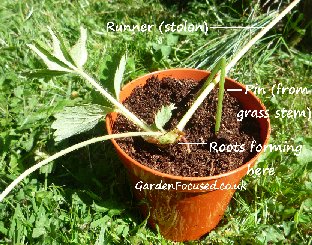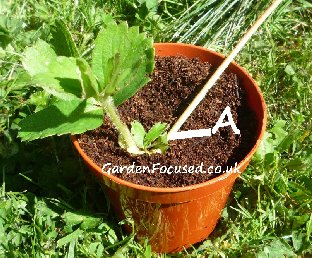Other pages on strawberries are shown below:
CALENDAR |
WHICH VARIETY? |
SOIL & POSITION |
WHEN TO BUY? |
PLANTING |
CARE & HARVEST |
PEST & DISEASE |
PROPAGATION |
POTS, GROWBAGS |
There are three methods which strawberry plants use to propagate themselves and these are:
- Putting out runners which touch the ground where roots are forming (see picture below). The roots sense the ground and grow into it forming a new plant. The runner connecting mother plant to the new plant eventually shrivel off and die leaving a new independent strawberry plant.
- Strawberries have small seeds on their surfaces and these can, if conditions are correct, germinate and grow into new plants. Unfortunately the seeds will not come true to type so unless you are willing to experiment for several years this is not a good method for the amateur gardener.
- The crown of the plant occasionally divides into two plants but waiting for this to occur will try the patience of most gardeners so we don’t recommend it.
The first rule for growing new strawberry plants from runners is to be sure that the mother plant is healthy. Runners from an unhealthy mother plant will produce unhealthy new plants. Always use only runners from strawberry plants in their first year of producing fruit to help ensure the runners are healthy. Any older and the plant will have begun to develop disease.
The picture above (click it to enlarge it and see more clearly) shows everything you need to propagate from runners:
- A healthy strawberry plant runner with a node where the roots are beginning to form.
- A small pot of general purpose compost which has been watered well.
- A peg of some sort to gently hold down the runner onto the soil. The simplest peg (the one we use and shown in the photo above) is a strongish stem of grass bent in the middle.
The best time of year to grow new strawberry plants from runners is June to July. If you grow the new plant at this time of year it will have time to form some of the plant parts associated with flowering before winter sets in and this will get you off to a head start next year.
Fill the pot (a 7cm /3in one is fine) with normal multi-purpose compost and water well, preferably from below letting the filled pot sit in shallow water for an hour.
Find a runner with a node (where the roots are forming) on it that has a couple of leaves. Place the underside of the node onto the top of the compost and press it down slightly but don’t bury it. Now peg the node into place on the soil surface, we used a strongish stem of grass and bent it to form the peg but anything will do just to gently hold the node in contact with the compost. Within a couple of weeks the node will have rooted into the compost and the peg will almost be redundant.
Leave things as they are for another two weeks (a month in total) and the node will have fully rooted into the compost. When the new plant has rooted cut off the runner stem on both sides of the node. The picture above shows the plant with outward runner stem cut off (compare with previous picture) and you also need to cut off the inward runner stem at point A as shown in the picture above. This will leave with you a new strawberry plant disconnected from the mother plant.
Leave the plant to settle down further for a couple of weeks ensuring the compost is kept moist but not water-logged. It can then be planted into its final position ready to overwinter and burst into growth next year.
FIND OUT MORE ABOUT STRAWBERRIES BELOW
CALENDAR |
WHICH VARIETY? |
SOIL & POSITION |
WHEN TO BUY? |
PLANTING |
CARE & HARVEST |
PEST & DISEASE |
PROPAGATION |
POTS, GROWBAGS |


GROW NEW STRAWBERRY PLANTS FROM RUNNERS
By David Marks
By far the easiest way to grow new strawberry plants yourself is to grow them from runners. Runners are those tendrils which sprout out from the centre of the pant and run out over the soil surface. This happens without you doing anything, the technical name for a runner like this is a stolon.
The success rate for an amateur gardener growing new strawberry plants from these runners is about 90% so success is almost certain! Give it a try, after all, it’s free.